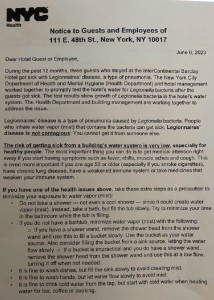All fields are required
Posted in Legionella,Legionnaire's disease,Our Blog,Outbreaks & Recalls on June 21, 2023

Guests and employees of the InterContinental New York Barclay hotel were notified by the NYC Department of health recently that, so far, three guests of the hotel have been sickened with Legionnaires’ disease. Here is everything we know about InterContinental New York Barclay Legionnaires’ Disease:
InterContinental New York Barclay Legionnaires’ Disease – NYC Health Notice
The June 6, 2023 notice has been provided to hotel guests as follows “During the past 12 months, three guests who stayed at the InterContinental Barclay Hotel got sick with Legionnaires’ disease, a type of pneumonia. The New York City Department of Health and Mental Hygiene (Health Department) and hotel management worked together to promptly test the hotel’s water for Legionella bacteria after the guests got sick. The test results show growth of Legionella bacteria in the hotel’s water system. The Health Department and building management are working together to address the issue.”

The hotel also provided guests with its own notice:
We are delighted you have chosen to stay with us and would like to wish you a warm welcome to the InterContinental New York Barclay.
As our highest priority remains the safety and well-being of our guests, it is imperative we inform you of a remediation process currently underway with the New York City Department of Health (hereinafter “DOH”).
Recently, the DOH requested our cooperation to collect and test a variety of water samples from throughout the building. The testing revealed very low levels of Legionella bacteria present in some of the samples collected.
The DOH has assured us that it is safe for guests to stay at the hotel, and as a resident in the building myself, I have the utmost of faith in both our city and our team to remediate this issue expeditiously. While you are with us, you may notice that the water temperature is hotter than you are ordinarily accustomed to. This is part of a proactive effort to ensure that the water remains safe. During this time, we ask you to be mindful of the elevated temperature levels in our sinks, showers and bathtub fixtures and be sure to activate both the cold and warm water dials.
How Does This Happen?
Hotels, hospitals, and other large building use water towers to provide water to plumbing and even cooling systems. These large vats of water can become contaminated with many different types of bacteria, such as Legionella without proper precautions.
A small number of bacteria can rapidly multiply if disinfection and sanitation procedures are not followed. Sometimes this lapse occurs due to inadequate measures in place or a temporary lapse in protocol.
In these cases, sufficient numbers of the bacteria present in the water may become infectious to those who are at risk.
Hotel is Cleaning Up the Issue, But Risk is Ongoing
Despite the hotels’ current efforts to disinfect the building’s water system, the risk of Legionnaire’s disease persists. Recent, current, and future guests are still very much at risk of contracting this harmful illness, though the Health Department indicates that guests who stayed and the affected hotel over 2 weeks ago and have not developed illness are in the clear and no longer at risk for the disease as a result of their stay. While it can sometimes take longer for symptoms to appear, oftentimes individuals begin to fall ill within 2 weeks of exposure. Though symptoms sometimes mislead healthcare providers as they are similar to other pneumonia or pneumonia-like illnesses.
Most healthy people exposed to Legionella do not go on to develop Legionnaire’s disease, but some people with certain conditions are more susceptible to the harmful bacteria. Those over the age of 50, former and current smokers, and those with certain medical conditions such as chronic lung disease or weakened immune systems are of highest risk.
Those with Risk Factors Are Encouraged to Find Alternative Accommodations
Guests who recently visited or plan to stay at the hotel should monitor their health for 2 weeks following their stay for Legionnaire’s symptoms, which include:
If symptoms develop within 2 weeks of check-out date, guests should immediately contact their healthcare provider and indicate Legionnaire’s disease risk.
You may have noticed that these symptoms sound familiar. They are similar to many flu-like illnesses such as those displayed in COVID-19. Appropriate testing will be needed to determine the cause of symptoms to provide specific treatment to ensure a better recovery outcome.
Guests who have a higher risk of contracting Legionnaire’s disease are encouraged to find alternative accommodations or take appropriate precautions such as avoiding exposure to water while visiting the hotel. This includes limiting use of sinks, not showering at the hotel, and not using tap water for respiratory equipment such as a CPAP machine.
Treatment
Legionnaire’s disease is treatable and responds well to treatment if caught early and detected. Determining Legionella infection is the most important part as it is often overlooked. Detection often involves testing patient urine and sputum for the bacterium. Specific antibiotics work well, but most people who become sick with the disease need hospital care to make a full recovery and about 1 in 10 people infected with Legionnaire’s disease will die from the illness.
What Should I Do if I Am Infected?
If you believe your symptoms are consistent with Legionella infection, seek medical attention immediately and indicate the potential link to the disease so appropriate tests can be performed to ensure proper treatment and recovery.
While anyone can be exposed to the Legionella bacterium, most health people show no symptoms or recover quickly. For some, Legionnaires’ is a greater concern. People who are 50 years or older have a higher risk of infection along with those with certain medical issues. People with chronic lung disease such as obstructive pulmonary disease or emphysema are at a higher risk. Those with a weak immune system or take drugs that weaken the immune system (such as chemotherapy and drugs taken after a transplant operation) are also at a higher risk. People with cancer, underlying illness such diabetes, kidney failure and liver failure are in this high-risk category as well.
The Center for Disease Control and Prevention (CDC) recommends testing the patient for Legionnaires’ disease if the patient is in Intensive Care and has severe pneumonia or has pneumonia and a weakened immune system. The patient should be tested for Legionnaires’ disease if they have been treated with antibiotics, but symptoms have not resolved. If the patient has travelled away from home within the past two weeks and then became ill they may have come in contact with Legionella pneumophila and should be tested for Legionnaires’. Additionally, if the patient may have acquired pneumonia in a nursing home or hospital, they should be tested for Legionnaires’. Of course, if the patient has pneumonia during a legionellosis outbreak, they should be tested for Legionnaires’ disease.
You should contact your health care provider and/or the local health department if you believe you may have been exposed to Legionella and you have symptoms such as fever, cough, chills, or muscle aches.
Legionnaires’ disease is treated with antibiotics. In severe situations, life-threatening complications may occur, such as lung and kidney failure. Other complications include septic shock caused by a subsequent blood infection that may cause a sudden and unsafe drop in blood pressure.
Health care providers have four common ways of detecting the Legionella bacterium to diagnose legionellosis or Legionnaires’ disease. These include antigen testing, culture, antibody testing, and genetic testing. A urine or respiratory sample is required to complete these tests. The CDC suggests antigen and culture testing to diagnose Legionnaires’ disease. Additional testes such as sputum culture, gram staining, complete blood count, and chemistry panels may also be ordered to help give a bigger picture of the patients’ overall health and any other ailment the body may be fighting. An additional blood sample may be required for these tests.
Antigen testing is often performed as an initial test if Legionnaires’ is suspected and provides a rapid result. This testing is specific to Legionella pneumophila and detects one of the bacterium’s proteins. This can be found in the urine and sometimes other bodily fluids, but urine is the most common sample used. A negative test result does not necessarily rule out the infection, as it only detects the serogroup 1 of Legionella pneumophila, though most cases of Legionnaires’ disease in the United States are a result of this specific bacteria. This is a quick method to get a yes or no answer. The “yes” allows the health care provider to look into specific treatment right away. The “no” just means that the physician will continue the diagnostic process, which will likely include a bacterial culture regardless of the positive or negative outcome of the test.
To confirm the presence of Legionella bacteria and diagnose Legionnaires’ disease, a bacterial culture is often performed on sputum. Sputum is a medical term for what someone coughs up as a result of respiratory illness. The laboratory uses a special nutrient media that encourages the growth of Legionella and discourages the growth of other bacteria. For this reason, it is considered the “gold standard” and a confirmation tool to diagnose the infection. This test takes a little bit of time, though a positive culture may grow between 48 and 72 hours. Negative cultures are held for seven days before a final result is reported to be sure no growth occurs.
Antibody testing using Direct fluorescent antibody (DFA) staining for Legionella species is another diagnostic tool a physician may use to diagnose Legionnaires’ disease. This is a rapid test that uses a specialized stain that attaches to antibodies specific to Legionella bacteria. This test can provide results in as little as 2 to 4 hours.
This disease is often underdiagnosed because many who are infected do not develop any symptoms. Additionally, of those who do have symptoms often go undiagnosed, as the sickness presents symptoms similar to other types of pneumonia. Specialized laboratory tests must be performed to confirm the presence of the bacterium to properly diagnose the illness of legionellosis. These tests aren’t generally performed on someone presenting pneumonia symptoms unless Legionnaires’ is considered a possibility. Common diagnostic tools include detecting bacteria found in sputum, finding presence of antigens in urine, or in blood samples by comparing two different samples taken three to six weeks apart.
Yes. If the owner of a building was negligent in failing to properly reduce or prevent the spread of legionella bacteria and this causes a Legionnaires’ disease outbreak, then victims of Legionnaires’ disease can pursue a lawsuit against the negligent parties to obtain compensation.
Our mission is to help families who have been harmed by contaminated food or water. When corporations cause food poisoning outbreaks or Legionnaires disease outbreaks, we use the law to hold them accountable. The Lange Law Firm is the only law firm in the nation solely focused on representing families in food poisoning lawsuits and Legionnaires disease lawsuits.
If you were infected with Legionnaires disease in the InterContinental New York Barclay Legionnaires’ Disease Outbreak and are interested in making a legal claim for compensation, we can help. Call us for a free no obligation legal consultation at 833.330.3663, or send us an e-mail here.